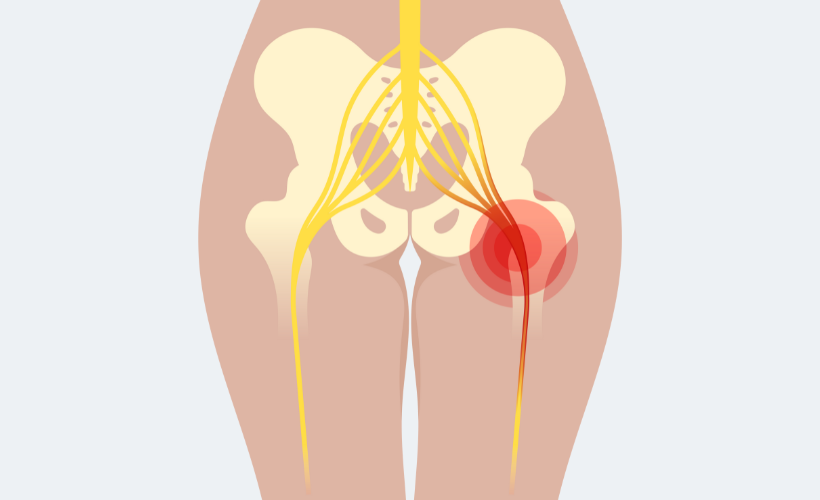Are Flip-flops Causing your Foot Pain? Physical Therapy for Piriformis Syndrome

Your summer footwear choices might be creating more problems than you think. While flip-flops offer convenience and comfort during warm weather, they can trigger a cascade of biomechanical issues that extend far beyond your feet and affect the lower back. ProTouch Physical Therapy sees many patients who develop piriformis syndrome after switching to flip-flops during summer months. This condition affects the deep muscle in your buttocks and can cause significant low back pain that radiates down your leg.
What Is Piriformis Syndrome?
Piriformis syndrome occurs when the piriformis muscle becomes tight, inflamed, or spasms. This small but important muscle connects your lower spine to your thighbone and sits deep in your buttock area. The piriformis muscle helps stabilize your hip joint and assists with rotating your leg outward.
The sciatic nerve travels very close to this muscle, and in some people, the sciatic nerve that takes an abnormal path actually passes through the piriformis muscle. When the piriformis muscle presses against or irritates this nerve, it creates compression of the sciatic nerve. Medical professionals call this primary piriformis syndrome when the muscle itself causes the sciatic nerve compression, distinguishing it from cases of sciatica caused by disc herniation or other spinal issues.
This condition affects approximately 6% of people with lower back pain complaints and is sometimes referred to as deep gluteal syndrome. Women experience piriformis syndrome six times more often than men, likely due to anatomical differences in the pelvis and hip structure around the sciatic notch.
The Flip-Flop Connection: How Summer Shoes Trigger Problems
Flip-flops force your feet to work differently than they do in supportive shoes. Your toes must grip the sole to keep the shoe attached to your foot with each step. This constant gripping action changes how you walk and stand, creating one of the primary causes of sciatic nerve irritation.
Altered Walking Pattern
When you wear flip-flops, your gait cycle changes significantly. You take shorter steps to prevent the shoes from flying off. Your feet also tend to slap down harder with each step since you cannot roll through your foot naturally.
These changes create a ripple effect up your kinetic chain. Your ankles work differently, which affects your calves, knees, hips, and ultimately your piriformis muscle. The muscle must work harder to stabilize your pelvis when your foundation becomes unstable, which may be more likely to create pressure on the nerve.
Lack of Arch Support
Flip-flops provide virtually no arch support. Your feet flatten with each step, causing your knees to roll inward and your hips to shift position. This altered alignment places additional stress on your piriformis muscle as it attempts to maintain pelvic stability and normal range of motion.
Increased Muscle Tension
The combination of altered mechanics and increased workload causes your piriformis muscle to become tight and overactive. Over time, this leads to compression or irritation of nearby nerves and eventually the many symptoms associated with piriformis syndrome. Prolonged sitting after long periods in flip-flops can worsen this condition.
Recognizing Piriformis Syndrome Symptoms
Many people mistake piriformis syndrome for other conditions because the symptoms and signs can mimic sciatica or low back pain. Understanding the specific signs helps you identify the issue early and seek appropriate treatment. Piriformis syndrome typically presents with distinct patterns that help differentiate it from other causes.
Common symptoms include:
- Deep buttock pain that may travel down through the buttocks
- Pain that worsens when sitting, especially on hard surfaces
- Difficulty climbing stairs, walking uphill, or bending the knee under load
- Pain that increases after sitting for extended periods
- Numbness or tingling down your upper leg
- Pain during hip rotation movements
- Discomfort when crossing your legs
- Aching that originates in the lower back and can travel into the hip area
The pain pattern typically differs from true sciatica. Pain due to piriformis syndrome usually stays more localized to the buttock and upper thigh, while sciatica often extends all the way to your foot. The sciatic nerve that runs through or alongside the piriformis muscle creates a unique pain pattern that extends from the buttock and down the back of the thigh. These symptoms occur when the irritated nerve travels through tight muscle fibers.
How Physical Therapy Addresses Piriformis Syndrome
Physical therapy offers the most effective treatment for piriformis syndrome. Unlike pain relievers such as naproxen that only mask symptoms temporarily, physical therapy addresses the root causes of the problem and provides long-term solutions.
Comprehensive Assessment
ProTouch Physical Therapy begins with thorough diagnosis and treatment planning to determine the exact cause of your symptoms. The assessment includes analyzing your posture, movement patterns, and muscle imbalances. This comprehensive approach ensures that treatment targets all contributing factors, not just the painful area.
Manual Therapy Techniques
Skilled physical therapists use hands-on techniques to release tension in the piriformis muscle and surrounding tissues. These methods help stretch through the back of the hip and include:
- Deep tissue massage to break up adhesions
- Trigger point release to eliminate painful knots
- Joint mobilization to restore proper hip mechanics
- Myofascial release to improve tissue flexibility
Targeted Exercise Program
A specific exercise program helps restore normal muscle function and prevent piriformis syndrome in the future. The program typically includes stretching exercises to lengthen tight muscles, strengthening exercises to address weak areas, and coordination exercises to retrain proper movement patterns and improve range of motion.
Advanced Treatment Approaches at ProTouch Physical Therapy
ProTouch Physical Therapy offers specialized treatment methods that go beyond standard physical therapy approaches. Their experienced team brings 25 years of combined expertise to address complex conditions like piriformis syndrome.
Schroth Method Integration
While primarily used for scoliosis treatment, the Schroth Method principles help correct postural imbalances that contribute to piriformis syndrome. This approach focuses on three-dimensional spinal alignment and breathing patterns that support optimal posture.
Whole-Body Assessment
The team at ProTouch Physical Therapy examines how your entire body works together. They look at foot mechanics, ankle mobility, knee alignment, hip function, and spinal posture to identify all factors contributing to your piriformis syndrome.
One-on-One Treatment
Unlike high-volume clinics, ProTouch Physical Therapy provides individualized attention without time constraints. This approach allows for thorough treatment sessions that address your specific needs and concerns.
Prevention Strategies: Protecting Yourself from Future Problems
Prevention remains the best approach to avoiding piriformis syndrome. Simple lifestyle changes to your footwear choices and daily habits can make a significant difference in reducing low back pain and preventing nerve irritation.
Choose Better Summer Footwear
Look for sandals with:
- Arch support built into the footbed
- Heel straps to prevent gripping with your toes
- Cushioned soles for shock absorption
- Proper heel-to-toe drop for natural walking
Strengthen Your Foundation
Key exercises for prevention include:
- Clamshells to strengthen hip external rotators
- Glute bridges to activate dormant glute muscles
- Piriformis stretches to maintain muscle length
- Core strengthening to support pelvic stability
Modify Your Activities
If you must wear flip-flops, limit the time and distance you walk in them. Save them for short trips to the pool or beach rather than long walks or standing activities.
When to Seek Professional Help
Early intervention produces the best outcomes for piriformis syndrome. Seek professional help from a qualified healthcare provider if you experience persistent deep buttock pain that lasts more than a few days, pain that interferes with your sleep or daily activities, or symptoms that worsen despite rest and basic stretching.
ProTouch Physical Therapy specializes in treating complex orthopedic conditions using evidence-based approaches. Their team understands the connection between foot mechanics and hip function, making them uniquely qualified to provide proper diagnosis and treatment for piriformis syndrome caused by improper footwear.
Recovery Timeline and Expectations
Most people with piriformis syndrome see significant improvement within 4-6 weeks of consistent physical therapy treatment. However, recovery time varies based on how long you've had symptoms, the severity of the condition, and your commitment to the treatment program.
The initial phase focuses on reducing pain and inflammation due to piriformis syndrome. The second phase emphasizes restoring normal movement and flexibility. The final phase concentrates on strengthening and prevention strategies to avoid future episodes of low back pain and hip dysfunction.
Take Action Against Piriformis Syndrome Today
Don't let improper summer footwear choices lead to months of pain and limited activity. ProTouch Physical Therapy offers the specialized expertise and personalized care needed to resolve piriformis syndrome effectively. Their comprehensive approach addresses not just your symptoms but the underlying causes that led to the problem in the first place.
Understanding the connection between flip-flops and piriformis syndrome empowers you to make better choices for your long-term health. With proper treatment and prevention strategies, you can enjoy summer activities without fear of developing this painful condition.
Contact ProTouch Physical Therapy at (908) 325-6556 to schedule your comprehensive evaluation. Located at 570 S Ave E Building G, Suite C, Cranford, NJ, their experienced team is ready to help you return to pain-free movement and prevent future episodes of piriformis syndrome.



